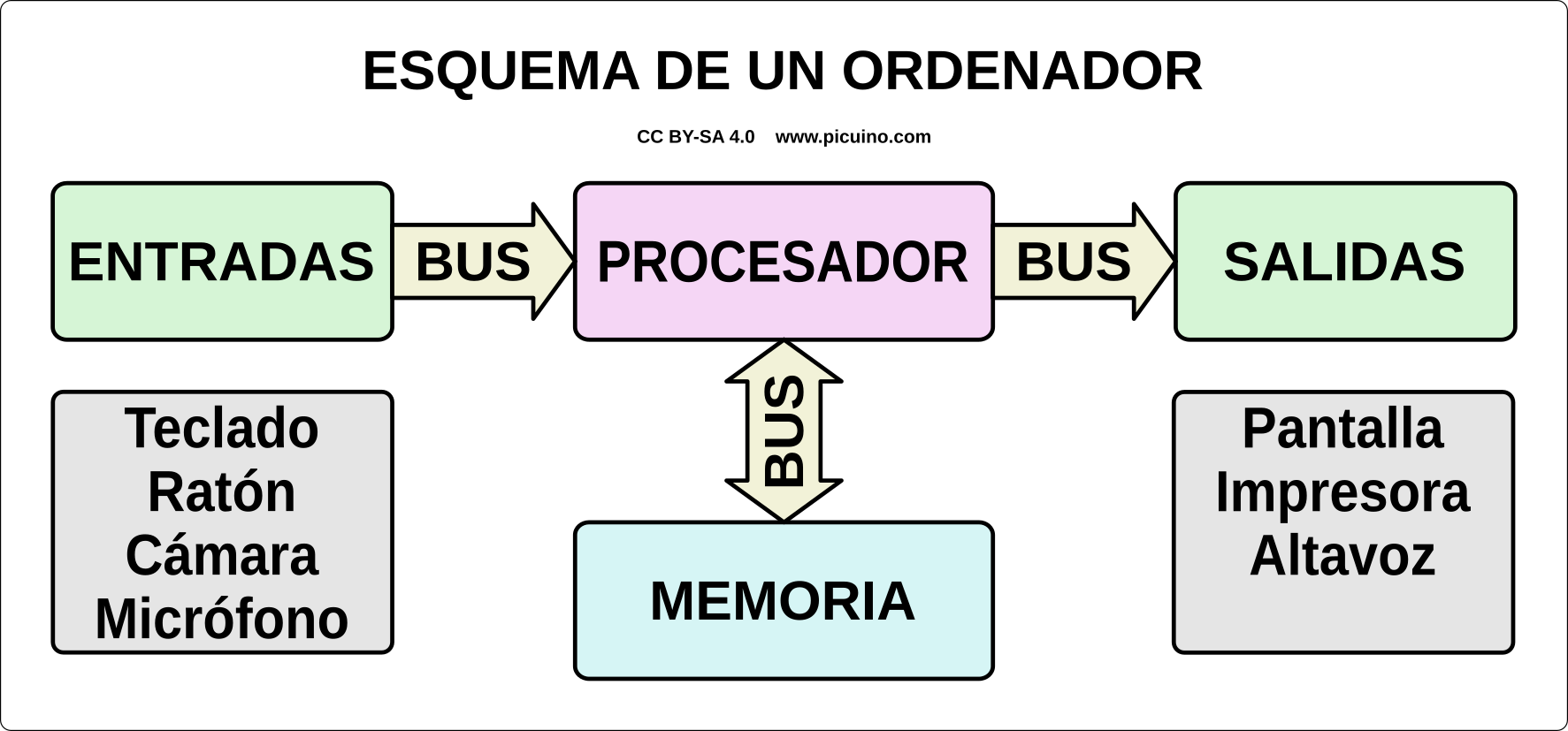Introduction to hardware¶
El hardware (pronunciado jard.wer) es el conjunto de las partes físicas de un sistema informático. Son los componentes eléctricos, electrónicos y mecánicos de un ordenador tales como cables, cajas, periféricos, etc.
On the contrary, the programs and data of a computer are intangible and are called software (pronounced soft.wer).
Computing¶
Computer science is the science that is responsible for the study of the techniques, technologies and tools necessary to collect, store, process and transmit information efficiently and safely.
Computer science includes a variety of fields, such as programming, databases, artificial intelligence, cryptography, computer networks, hardware configuration, among others.
Advances in computing have enabled the development of computing devices and systems that make our daily lives easier and have completely transformed the way we communicate and access information.
Computers¶
The Spanish word 'ordenador' comes from the French "ordinateur" coined for commercial purposes by the IBM company in 1955 in France. This term refers to the ability of computers to order and classify large amounts of data, such as lists of names in alphabetical order.
On the contrary, in the Anglo-Saxon world and in Latin America it is more common to use the word computador, from the English "computer". This word was used to refer to a person dedicated to performing mathematical calculations and was later adapted to refer to the machines that perform this function.
Historical milestones of computing¶
In 1725, a Frenchman, the son of an organ maker, Basile Bouchon, adapted the concept of clockwork used in music boxes to the repetitive task of a loom, operated through a perforated tape.
In 1801 the Frenchman Joseph Marie Jacquard invented an automatic loom using punched cards to program the loom. This allowed even the most inexperienced users to create complex designs and patterns on the fabrics.
The British mathematician Charles Babbage built between 1833 and 1842 a programmable mechanical machine to make any type of calculation, the analytical machine, which did not work due to mechanical problems that were difficult to solve at the time.
His innovative project included all the elements of a computer as we think of it today. It had input devices based on the punched cards of the Jacquard loom, an arithmetic processor that calculated numbers, a control unit that determined which task should be performed, an output mechanism and a memory where the numbers could be stored until they were processed.
The mathematician and writer Ada Lovelace, together with Babbage, created the first program for the mechanical computer, which is why she is considered the first computer programmer in history.
Herman Hollerith developed the punch card data processing technology for the 1890 United States Census and founded the Tabulating Machine Company which would later join two other companies to form present-day IBM. IBM manufactured and marketed a variety of recording machines for creating, sorting, and tabulating punch cards.
In 1936 the German Konrad Zuse created the first general computer in history, called Z1. The Z1 was the first fully programmable computer system. Their technology was based on electromechanical relays.
During the Second World War, computers based on vacuum valves were developed, faster than mechanical relays. The Colossus Mark I, made by the British in 1944, helped decipher the messages of the German enigma encryption machine. The ENIAC, developed by the US in 1946, was used to calculate ballistic shooting tables, among other functions.
In 1954 the TRADIC computer appeared, the first to use the new transistor technology, much faster, more reliable and smaller than vacuum tubes. Transistor technology is still used to make today's computers.
In 1971, the company Intel introduced the first microprocessor on a single chip, the 4004. A few years later, several 8-bit microprocessors appeared on a single chip, which served as the basis for the first mass-selling personal computers.
In 1977, three personal computers aimed at mass consumption appeared on the market, among which the Apple II stands out. Until then, computers were business-oriented machines. The era of personal computing begins.
In 1981 the IBM company launched its personal computer with the Microsoft operating system. This computer had an open design that allowed other companies to make clone computers compatible with the IBM. Most of today's desktop computers and laptops are based on this first IBM computer.
Around 1995, the Internet, a network limited to universities, computing centers or military bases, began to be used on a massive scale by all kinds of users. A few years later, in 1998, the company Google appears with a search engine that greatly facilitates web page searches on the Internet.
In 2007, the Apple company launched the first smartphone with a touch screen, the forerunner of all current smartphones. Computing is no longer associated with the desktop and begins to be permanently available in the user's pocket.
